 W
WThe ABC-79M (4x4) armoured personnel carrier has been developed in Romania and uses some automotive components of the TAB-77 armoured personnel carrier. Although previously known as TABC-79, it is now known as the ABC-79M.
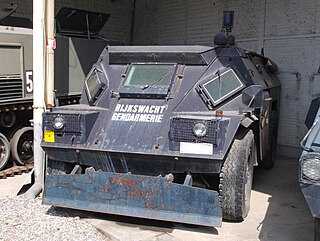 W
WThe BDX is a Belgian armored personnel carrier developed on the basis of the Irish designed Timoney armored vehicle.
 W
WThe BRDM-1 is a Soviet amphibious armored scout car. It was the first purpose-built Soviet reconnaissance vehicle to enter service since the BA-64 and was built on the chassis and drive train of the BTR-40 armored personnel carrier. It is the world's first mass-produced combat vehicle of its class.
 W
WThe BRDM-2 is an amphibious armoured scout car used by Russia and the former Soviet Union. It was also known under the designations BTR-40PB, BTR-40P-2 and GAZ 41-08. This vehicle, like many other Soviet designs, has been exported extensively and is in use in at least 38 countries. It was intended to replace the earlier BRDM-1, compared to which it had improved amphibious capabilities and better armament.
 W
WThe BTR-3 is an Eight-wheel drive armored personnel carrier developed in 2000-2001 by an international consortium. The companies involved in the project include the Kharkiv Morozov Machine Building Design Bureau of Ukraine, the ADCOM MANUFACTURING Company of Abu-Dhabi, UAE, and the State Scientific Technical Centre of Artillery & Rifle Arms of Ukraine. Although somewhat similar in appearance to the Russian BTR-80, the BTR-3U is an all-new production vehicle rather than an update of the existing in-service vehicle.
 W
WThe BTR-4 "Bucephalus" is an amphibious 8x8 wheeled armoured personnel carrier (APC) designed in Ukraine by the Kharkiv Morozov Machine Building Design Bureau.
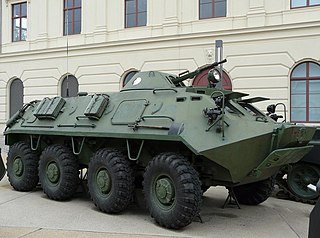 W
WThe BTR-60 is the first vehicle in a series of Soviet eight-wheeled armoured personnel carriers (APCs). It was developed in the late 1950s as a replacement for the BTR-152 and was seen in public for the first time in 1961. BTR stands for Bronetransporter.
 W
WThe BTR-70 is an eight-wheeled armored personnel carrier originally developed by the Soviet Union during the late 1960s under the manufacturing code GAZ-4905. On August 21, 1972, it was accepted into Soviet service and would later be widely exported. Large quantities were also produced under license in Romania as the TAB-77.
 W
WThe BTR-80 is an 8×8 wheeled amphibious armoured personnel carrier (APC) designed in the USSR. It was adopted in 1985 and replaced the previous vehicles, the BTR-60 and BTR-70, in the Soviet Army. It was first deployed during the Soviet–Afghan War.
 W
WBTR-90 (GAZ-5923) is an 8×8 wheeled armored personnel carrier developed in Russia, designed in 1993 and first shown publicly in 1994. It is a larger version of the BTR-80 vehicle, fitted with a BMP-2 turret. Armour protection is improved compared with the BTR-80, giving protection from 14.5 mm projectiles over the frontal arc.
 W
WThe Cadillac Gage Commando, frequently denoted as the M706 in U.S. military service, is an American armored car designed to be amphibious. It was engineered by Cadillac Gage specifically for the United States Military Police Corps during the Vietnam War as an armed convoy escort vehicle. The Commando was one of the first vehicles to combine the traditionally separate roles of an armored personnel carrier and a conventional armored car, much like the Soviet BTR-40. Its notable height, amphibious capability, and waterproofed engine allowed American crews to fight effectively in the jungles of Vietnam by observing their opponents over thick vegetation and fording the country's deep rivers.
 W
WThe D-442 FUG and D-944 PSZH are the results of Hungarian domestic development of relatively cheap amphibious armoured scout car and armored personnel carrier series. FUG and PSZH were exported with limited success, thus it is also known under its Czechoslovak designation OT-65.
 W
WThe DefTech AV8 Gempita (Thunder) is an amphibious multirole armoured vehicle developed by Malaysian defence company DefTech with the assistance of Turkey defence company FNSS. The Gempita resembles some of the Turkey FNSS Pars design and technology. The vehicle has a modular design which allows the fitting of different turrets, weapons, sensors, and communications systems on the same vehicle.
 W
WThe Didgori Medevac is a Georgian-made medical armoured personnel carrier developed by the "Delta" research center of the Ministry of Defence of Georgia and part of the Didgori-series APC family currently constructed in five baseline variants.
 W
WThe Didgori-1 is a Georgian-made armoured personnel carrier developed by the "Delta" research center of the Ministry of Defence and part of the Didgori-series APC family currently constructed in five baseline variants.
 W
WThe Dragoon 300 AFV was produced by Arrowpointe Corporation during the 1980s. It was based on the automotive components of the United States Army's M113 APCs and 5-ton trucks. It resembles a larger V-150 Commando.
 W
WThe EE-11 Urutu is a Brazilian amphibious armored personnel carrier. It was based on the drive train and chassis components of the EE-9 Cascavel armored car and initially emerged as part of a project to develop an amphibious troop-carrying counterpart to that vehicle for the Brazilian Army and Marine Corps (CFN). The first pre-production models entered service with the CFN in 1973 and serial production commenced the following year. While the CFN declined to adopt the EE-11 Urutu in large numbers, the Brazilian Army was more forthcoming and purchased 223; these entered service in 1975.
 W
WThe Pars is an amphibious Armoured combat vehicle family with 4x4, 6×6 and 8×8 versions, produced by FNSS Defence Systems of Turkey.
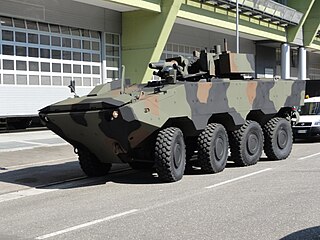 W
WThe Iveco SuperAV is an eight-wheel drive tactical vehicle developed by the Italian commercial vehicle company Iveco. A version made by BAE Systems was selected by the United States Marine Corps for the Amphibious Combat Vehicle program.
 W
WThe OT-64 SKOT is an amphibious, armored personnel carrier (8x8), developed jointly by Poland (PRL) and Czechoslovakia (ČSSR) well into the 1960s.
 W
WThe Cobra is a family of armored vehicles produced by Otokar of Turkey. It is produced in two generations.
 W
WThe Patria Pasi is a Finnish-made six-wheeled armoured personnel carrier (APC) originally designed for Finnish Defence Forces. The first version was produced in 1983 and serial production began in 1984. It was designed to operate with ease of use, simple structure and low-cost maintenance. The basic appearance and configuration of Patria Pasi is similar to most wheeled APCs. The XA-180 and XA-185 versions are fully amphibious while the XA-203 is not.
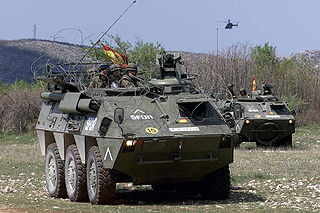 W
WThe Pegaso 3560 BMR is a 6x6 wheeled armoured personnel carrier produced in Spain by Enasa since 1979.
 W
WThe PMPV MiSu is a Finnish made six-wheeled amphibious mine-resistant ambush protected armoured personnel carrier (APC) designed for the Finnish Defence Forces as a possible replacement for its XA-180-series vehicles. The first version was produced in 2015 and test production began in 2017. It was designed to operate with ease of use, simple structure and low-cost maintenance. The basic appearance and configuration of PMPV Misu is similar to most wheeled MRAPs. The Misu is fully amphibious.
 W
WThe RG-34 is a South African Mine-Resistant Ambush Protected vehicle (MRAP). Specially designed to be mine-resistant, it has been produced in multiple variants, equipped for troop or cargo transport, command, and fire support. Originally showcased with a wide turret ring and a 90mm rifled cannon, the RG-34 was one of the first MRAPs configured to carry a large gun system.
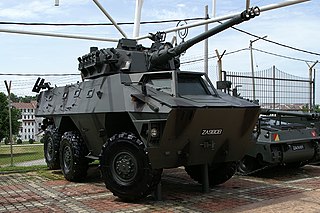 W
WThe SIBMAS is a Belgian amphibious infantry fighting vehicle. It was engineered from the same prototype as the South African Ratel. In appearance the vehicle is also similar to the Chinese WZ-523 armoured personnel carrier. The SIBMAS was developed between 1975 and 1976 at a department of the BN Constructions Ferroviaires et Metalliques in Nivelles. Production was on an order-by-order basis and commenced only for the Malaysian Army.
 W
WThe TPz (Transportpanzer) Fuchs ("fox") is a German armoured personnel carrier originally developed by Daimler-Benz but manufactured and further developed by the now Rheinmetall MAN Military Vehicles (RMMV). Fuchs was the second wheeled armoured vehicle to enter service with the Bundeswehr and it can be used for tasks including troop transport, engineer transport, bomb disposal, Nuclear, Biological and Chemical reconnaissance and electronic warfare. RMMV and its predecessors manufactured 1,236 Fuchs 1, mostly for the German Army.
 W
WThe Type 08 is a family of eight-wheeled amphibious, modular armored vehicle developed by Norinco for infantry fire support, battlefield logistics and quick reaction operations. It is a recent People's Republic of China produced Infantry fighting vehicle for People's Liberation Army Ground Force and People's Liberation Army Marine Corps.
 W
WThe Type 87 Reconnaissance and Patrol Vehicle, also known as Burakkuai or Type 87 ARV for short, is a 6x6 wheeled Armoured Fighting Vehicle designed and manufactured by multinational heavy industry manufacturer Komatsu Limited and employed exclusively by the Japanese Ground Self-Defense Forces. The JGSDF continued to commission new units up until as recently as 2013
 W
WThe VBTP-MR Guarani is a 6×6 armoured personnel carrier developed by Iveco and the Brazilian Army as part of its "URUTU-III" modernization program aimed to replace all EE-11 Urutu by 2015. The 8x8 version of the VBTP-MR is the base of Iveco's Superav armoured personnel carrier. In the program other Brazilian Companies also participated, such as IMBEL (Communications), ELBIT (Armaments), Usiminas and Villares.
 W
WThe Véhicule Blindé de Combat d'Infanterie is a French Infantry fighting vehicle designed to replace the AMX-10P. They entered active service with the French Army in 2008, with 630 vehicles ordered up to 2010. Spain and the UK have shown interest in the vehicle.
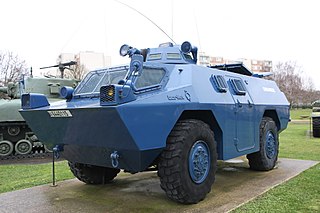 W
WThe Berliet VXB-170 is a four-wheel armoured vehicle used primarily as an internal security vehicle. Developed and initially produced by Berliet until Berliet was merged with Saviem to form Renault Trucks, it lost to the Saviem VAB the competition to equip the French Army, even though it was cheaper than its competitor. Production stopped after less than 200 vehicles had been produced.